The 4 Main Types Of Dragon Fruit And Their Differences
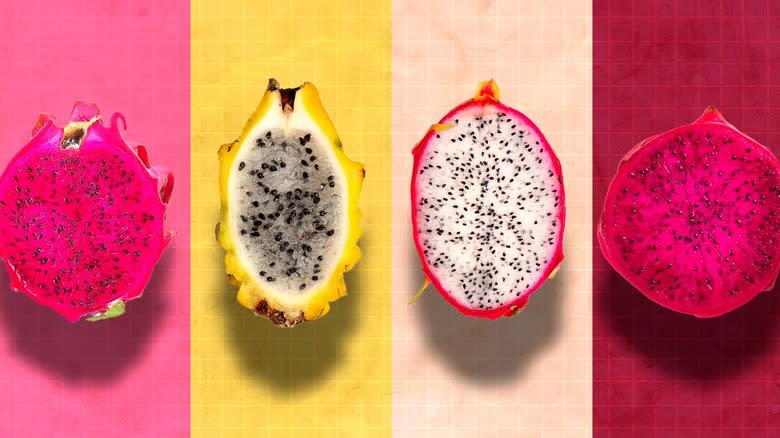
If you've ever traveled to Asia, Central America, South America, or Israel, you may have tried the spiky bright fruit with sweet, dotted flesh known as dragon fruit. You can find these fruits in the U.S. occasionally, too, but they're mostly grown on other continents. If you get your hands on one of these gems, however, there are a few things to keep in mind when you eat dragon fruit: You can either peel the skin off or scoop out the flesh, and a ripe fruit will retain a vibrant color without any brown spots.
Typically, the unique exterior of a dragon fruit (also called pitaya or strawberry pears) will make it stand out immediately -- not only its bright hue but the spiky leaves that firmly cement dragon fruits as members of the cactus plant family. But while the pink-skinned types are the most recognizable in the U.S., dragon fruits actually come in quite a few different colors of the rainbow, with each having subtle flavor differences. So, if you want to broaden your knowledge for your next venture into elevated salsa or a vivid dragon fruit-infused vodka cocktail, let's dive into the qualities that make each variety unique.
Read more: 13 Simple Tricks To Pick The Best Fresh Fruit Every Time
White Dragon Fruit
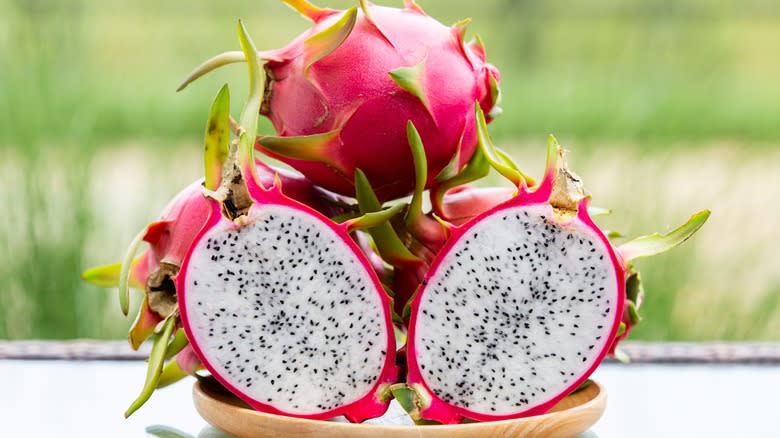
If you're not a huge dragon fruit aficionado, you likely picture the most common variety when you think of the fruit -- the type with pink skin and white insides. These beauties are sometimes known as white dragon fruits, by their scientific name Selenicereus undatus (formerly Hylocereus undatus), or by a plethora of cultivar nicknames including Alice, L.A. Woman, Seoul Kitchen, and David Bowie. They boast a vivid pink exterior and a Dalmatian-like white-and-black-seeded interior, and they're mostly grown in Central and South American countries such as Nicaragua and Ecuador. They also tend to be more affordable in the U.S. than their red-fleshed counterparts.
Although white dragon fruits are the most popular type, they're the least sweet of all the varieties. Despite their vibrant outer appearance, the flesh has a mild flavor reminiscent of kiwi fruits. These pink and white fruits are typically the largest out of all of the dragon fruits, and they're especially popular in Asia as a refreshing summer snack or ingredient. Most varieties offer a plethora of potential nutritional benefits and can help combat chronic disease and boost your immune system, but these white-fleshed gems may also reduce resistance to insulin.
Red Dragon Fruit
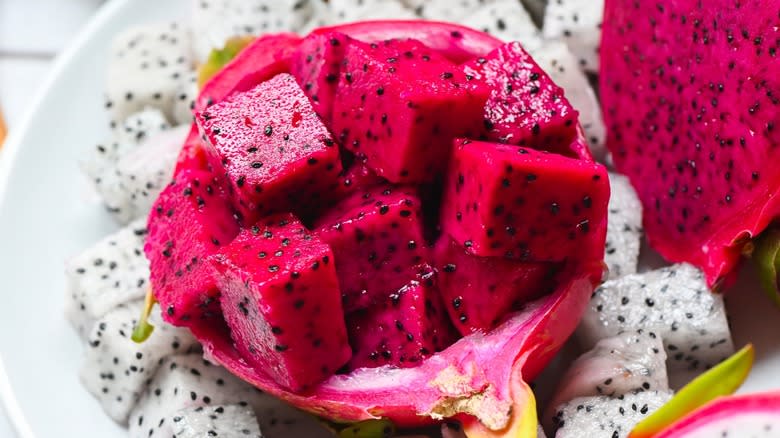
From the outside, you might mistake this variety (also called Selenicereus polyrhizus) for its white-fleshed brethren, but there are a few notable differences between the two. The exterior can vary from hot pink to a darker, beet-like hue, and these are often called red dragon fruits. Grown primarily in Nicaragua, this variety has tinier leaves, may be smaller in size overall, and tends to have more of an oval shape.
But you'll find these fruits' most defining feature when you cut them open, revealing blood-red insides with black seeds. This color of flesh has earned one variety the nickname Bloody Mary, although you'll also see fruits named Costa Rican Sunset, Zamorano, and Red Jaina. The latter's name derives from the lore surrounding the origins of the red dragon fruit, which says that it comes from the last breath of a dying dragon. The base of the tail, called the "jaina," was the source of the fallen creature's fire.
Due to their higher sugar content, these fruits are a little sweeter than the pink and white ones, with flavor notes reminiscent of berries, but they're also a little more acidic. While their juice is ideal for dying food or drinks a pretty scarlet color, it can also stain your hands and clothes if you're not careful. But if you're looking for dragon fruits with the antioxidant lycopene, you'll want to choose these red ones when purchasing dragon fruit.
Purple Dragon Fruit
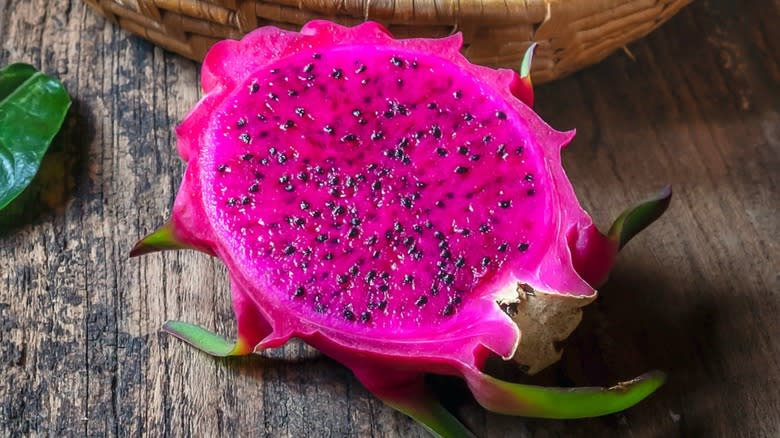
Some don't consider purple dragon fruit a separate type of fruit from the red version, choosing instead to only recognize three main varieties. It's true that, with their fuchsia skin and vibrant insides, the two look pretty similar. Purple dragon fruits even have more of an oval shape, reminiscent of their scarlet cousins. However, instead of blood-red flesh, you'll see meat with more of a magenta hue here, or what some call purple. Their flavor hits a middle ground between the milder white-fleshed variety and the sweeter red one, with notes ranging from kiwi to grape.
Purple dragon fruits also have plenty of cultivar nicknames, including Cosmic Charlie, Purple Haze, Voodoo Child, and American Beauty. Also known by its scientific name Selenicereus guatemalensis, purple dragon fruit is mostly grown in Guatemala, although you may see it harvested in Florida and California as well. It's one of the rarest types you can find in the U.S. and the American Beauty variety almost went extinct in 2014 because of disease, so if you see one, you'll want to snap it up and give it a try.
Yellow Dragon Fruit
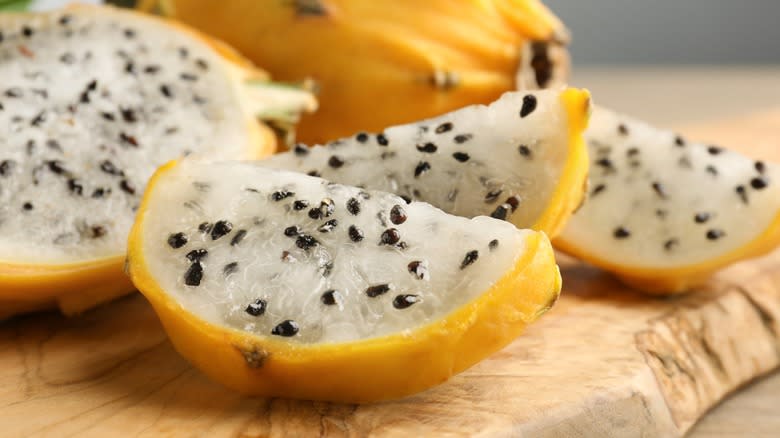
If you manage to get your hands on a rare yellow dragon fruit, you're in for a real treat, because this is the sweetest of all four of these varieties. Also called Selenicereus megalanthus, this type has sunny yellow skin, pointy knobs, and fewer attached leaves, making it almost resemble a small pineapple on the outside. These fruits are pretty tiny compared to the pink or red varieties, with the largest ones only reaching about four inches long. If you split one open, you'll find a smaller amount of large black seeds amidst pale yellow, almost white flesh -- along with plenty of juice, as these fruits carry the most liquid.
In addition to their sweet flavor, you'll get notes of florals and tang when biting into a yellow dragon fruit. You're more likely to find one of these varieties in U.S. grocery stores than a purple fruit, but not by much. Yellow dragon fruit originally comes from Central and South America, primarily Colombia and Ecuador, although it's often grown in Israel and Florida today as well. These sunny gems offer plenty of fiber, prebiotics, and antioxidants.
Read the original article on Tasting Table.

 Yahoo Finance
Yahoo Finance 